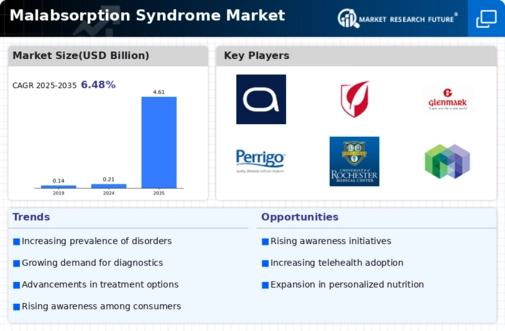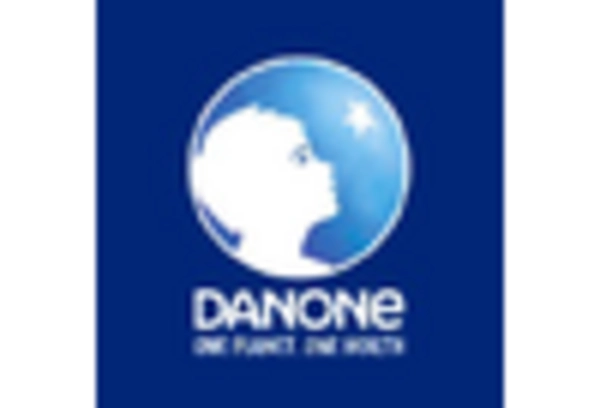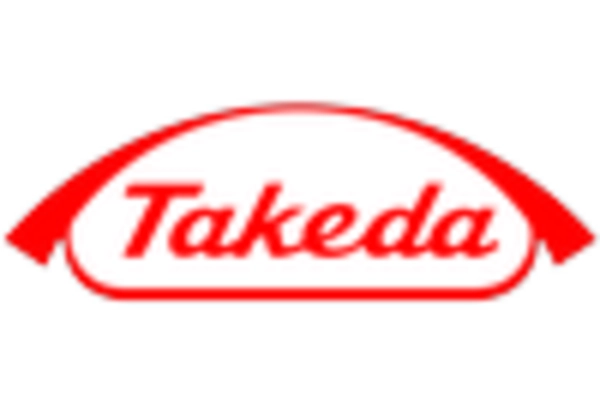-
Definition
-
Scope of the Study
- Research Objective
- Assumptions
- Limitations
-
Introduction
-
Primary Research
-
Secondary research
-
Market Size Estimation
-
Drivers
-
Restrains
-
Opportunities
-
Challenges
-
Macroeconomic Indicators
-
Technology Trends & Assessment
-
Porter’s Five Forces Analysis
- Bargaining Power of Suppliers
- Bargaining Power of Buyers
- Threat of New Entrants
- Threat of Substitutes
- Intensity of Rivalry
-
Value Chain Analysis
-
Investment Feasibility Analysis
-
Pricing Analysis
-
Chapter 6. Global Malabsorption Syndrome Market, by Diagnosis
-
Introduction
-
Hematologic Tests
- Market Estimates & Forecast, 2020 – 2027
-
Imaging Studies
- Market Estimates & Forecast, 2020 – 2027
-
Other Tests
- Market Estimates & Forecast, 2020 – 2027
-
Chapter 7. Global Malabsorption Syndrome Market, by Causative Diseases
-
Introduction
-
Lactose Intolerance
- Market Estimates & Forecast, 2020 – 2027
-
Cystic Fibrosis
- Market Estimates & Forecast, 2020 – 2027
-
Whipple’s Disease
- Market Estimates & Forecast, 2020 – 2027
-
Parasitic Diseases
- Market Estimates & Forecast, 2020 – 2027
-
Tropical sprue
- Market Estimates & Forecast, 2020 – 2027
-
Intestinal Disorders
- Market Estimates & Forecast, 2020 – 2027
-
Others
- Market Estimates & Forecast, 2020 – 2027
-
Chapter 8. Global Malabsorption Syndrome Market, by Treatment
-
Introduction
-
Nutritional Supplements
- Market Estimates & Forecast, 2020 – 2027
-
Gluten-Free Diet
- Market Estimates & Forecast, 2020 – 2027
-
Protease and Lipase Supplements
- Market Estimates & Forecast, 2020 – 2027
-
Antibiotics
- Market Estimates & Forecast, 2020 – 2027
-
Antidiarrheal Agents
- Market Estimates & Forecast, 2020 – 2027
-
Anti-Inflammatory Drugs
- Market Estimates & Forecast, 2020 – 2027
-
Chapter 9. Global Malabsorption Syndrome Market, by End User
-
Introduction
-
Pharmaceutical Companies
- Market Estimates & Forecast, 2020 – 2027
-
Hospitals
- Market Estimates & Forecast, 2020 – 2027
-
Nutrition Clinics
- Market Estimates & Forecast, 2020 – 2027
-
Academic and Research Institutes
- Market Estimates & Forecast, 2020 – 2027
-
Academic and Research Institutes
- Market Estimates & Forecast, 2020 – 2027
-
Chapter 10. Global Malabsorption Syndrome Market, by Region
-
Introduction
-
Americas
- North America
- South America
-
Europe
- Western Europe
- Eastern Europe
-
Asia Pacific
- Japan
- China
- India
- Australia
- Republic of Korea
- Rest of Asia Pacific
-
The Middle East & Africa
- United Arab Emirates
- Saudi Arabia
- Oman
- Kuwait
- Qatar
- Rest of the Middle East & Africa
-
Chapter 11 Company Landscape
-
Introduction
-
Market Share Analysis
-
Key Development & Strategies
- Key Developments
-
Chapter 12 Company Profiles
-
Abbvie, Inc.
- Company Overview
- Diagnosis of Causative Agents Overview
- Financials
- SWOT Analysis
-
Actelion Pharmaceuticals Ltd
- Company Overview
- Diagnosis of Causative Agents Overview
- Financial Overview
- Key Developments
- SWOT Analysis
-
AstraZeneca PLC
- Company Overview
- Diagnosis of Causative Agents Overview
- Financial Overview
- Key Development
- SWOT Analysis
-
Bayer Healthcare AG
- Company Overview
- Diagnosis of Causative Agents/Business Segment Overview
- Financial Overview
- Key Development
- SWOT Analysis
-
DSM
- Company Overview
- Diagnosis of Causative Agents Overview
- Financial overview
- Key Developments
-
ELI LILY AND COMPANY
- Company Overview
- Diagnosis of Causative Agents Overview
- Financial Overview
- Key Developments
-
Gilead Sciences
- Overview
- Diagnosis of Causative Agents Overview
- Financials
- Key Developments
- SWOT Analysis
-
Others
-
Chapter 13 MRFR Conclusion
-
Key Findings
- From CEO’s View Point
- Unmet Needs of the Market
-
Key Companies to Watch
-
Prediction of Malabsorption Syndrome Industry
-
Chapter 14 Appendix
-
LIST OF TABLES
-
Malabsorption Syndrome Industry Synopsis, 2020 – 2027
-
Malabsorption Syndrome Market Estimates and Forecast, 2020 – 2027, (USD Million)
-
Malabsorption Syndrome Market by Region, 2020 – 2027, (USD Million)
-
Malabsorption Syndrome Market by Diagnosis, 2020 – 2027, (USD Million)
-
Malabsorption Syndrome Market by Causative Diseases, 2020 – 2027, (USD Million)
-
Malabsorption Syndrome Market by Treatment, 2020 – 2027, (USD Million)
-
Malabsorption Syndrome Market by End User, 2020 – 2027, (USD Million)
-
North America Malabsorption Syndrome Market by Diagnosis, 2020 – 2027, (USD Million)
-
North America Malabsorption Syndrome Market by Causative Diseases, 2020 – 2027, (USD Million)
-
North America Malabsorption Syndrome Market by Treatment, 2020 – 2027, (USD Million)
-
North America Malabsorption Syndrome Market by End User, 2020 – 2027, (USD Million)
-
US Malabsorption Syndrome Market by Diagnosis, 2020 – 2027, (USD Million)
-
US Malabsorption Syndrome Market by Causative Diseases, 2020 – 2027, (USD Million)
-
US Malabsorption Syndrome Market by Treatment, 2020 – 2027, (USD Million)
-
US Malabsorption Syndrome Market by End User, 2020 – 2027, (USD Million)
-
Canada Malabsorption Syndrome market by Diagnosis, 2020 – 2027, (USD Million)
-
Canada Malabsorption Syndrome Market by Causative Diseases, 2020 – 2027, (USD Million)
-
Canada Malabsorption Syndrome Market by Treatment, 2020 – 2027, (USD Million)
-
Canada Malabsorption Syndrome market by End User, 2020 – 2027, (USD Million)
-
South America Malabsorption Syndrome Market by Diagnosis, 2020 – 2027, (USD Million)
-
South America Malabsorption Syndrome Market by Causative Diseases, 2020 – 2027, (USD Million)
-
South America Malabsorption Syndrome Market by Treatment, 2020 – 2027, (USD Million)
-
South America Malabsorption Syndrome Market by End User, 2020 – 2027, (USD Million)
-
Europe Malabsorption Syndrome Market by Diagnosis, 2020 – 2027, (USD Million)
-
Europe Malabsorption Syndrome Market by Causative Diseases, 2020 – 2027, (USD Million)
-
Europe Malabsorption Syndrome Market by Treatment, 2020 – 2027, (USD Million)
-
Europe Malabsorption Syndrome Market by End User, 2020 – 2027, (USD Million)
-
Western Europe Malabsorption Syndrome Market by Diagnosis, 2020 – 2027, (USD Million)
-
Western Europe Malabsorption Syndrome Market by Causative Diseases, 2020 – 2027, (USD Million)
-
Western Europe Malabsorption Syndrome Market by Treatment, 2020 – 2027, (USD Million)
-
Western Europe Malabsorption Syndrome Market by End User, 2020 – 2027, (USD Million)
-
Eastern Europe Malabsorption Syndrome market by Diagnosis, 2020 – 2027, (USD Million)
-
Eastern Europe Malabsorption Syndrome Market by Causative Diseases, 2020 – 2027, (USD Million)
-
Eastern Europe Malabsorption Syndrome Market by Treatment, 2020 – 2027, (USD Million)
-
Eastern Europe Malabsorption Syndrome Market by End User, 2020 – 2027, (USD Million)
-
Asia Pacific Malabsorption Syndrome Market by Diagnosis, 2020 – 2027, (USD Million)
-
Asia Pacific Malabsorption Syndrome Market by Causative Diseases, 2020 – 2027, (USD Million)
-
Asia Pacific Malabsorption Syndrome Market by Treatment, 2020 – 2027, (USD Million)
-
Asia Pacific Malabsorption Syndrome market by End User, 2020 – 2027, (USD Million)
-
The Middle East & Africa Malabsorption Syndrome Market by Diagnosis, 2020 – 2027, (USD Million)
-
The Middle East & Africa Malabsorption Syndrome Market by Causative Diseases, 2020 – 2027, (USD Million)
-
The Middle East & Africa Malabsorption Syndrome Market by Treatment, 2020 – 2027, (USD Million)
-
The Middle East & Africa Malabsorption Syndrome market by End User, 2020 – 2027, (USD Million)
-
LIST OF FIGURES
-
Research Process
-
Segmentation for Malabsorption Syndrome Market
-
Segmentation Market Dynamics for Malabsorption Syndrome Market
-
Global Malabsorption Syndrome market Share, by Diagnosis 2020
-
Global Malabsorption Syndrome market Share, by Causative Diseases 2020
-
Global Malabsorption Syndrome market Share, by Treatment 2020
-
Global Malabsorption Syndrome market Share, by End User, 2020
-
Global Malabsorption Syndrome market Share, by Region, 2020
-
North America Malabsorption Syndrome market Share, by Country, 2020
-
Europe Malabsorption Syndrome market Share, by Country, 2020
-
Asia Pacific Malabsorption Syndrome market Share, by Country, 2020
-
Middle East & Africa Malabsorption Syndrome market Share, by Country, 2020
-
Global Malabsorption Syndrome market: Company Share Analysis, 2020 (%)
-
Abbvie, Inc.: Key Financials
-
Abbvie, Inc.: Segmental Revenue
-
Abbvie, Inc.: Geographical Revenue
-
Actelion Pharmaceuticals Ltd: Key Financials
-
Actelion Pharmaceuticals Ltd: Segmental Revenue
-
Actelion Pharmaceuticals Ltd: Geographical Revenue
-
AstraZeneca PLC: Key Financials
-
AstraZeneca PLC: Segmental Revenue
-
AstraZeneca PLC: Geographical Revenue
-
Bayer Healthcare AG: Key Financials
-
Bayer Healthcare AG: Segmental Revenue
-
Bayer Healthcare AG: Geographical Revenue
-
DSM: Key Financials
-
DSM: Segmental Revenue
-
DSM: Geographical Revenue
-
ELI LILY AND COMPANY: Key Financials
-
ELI LILY AND COMPANY: Segmental Revenue
-
ELI LILY AND COMPANY: Geographical Revenue
-
Gilead Sciences: Key Financials
-
Gilead Sciences: Segmental Revenue
-
Gilead Sciences: Geographical Revenue

















Leave a Comment